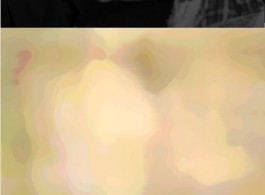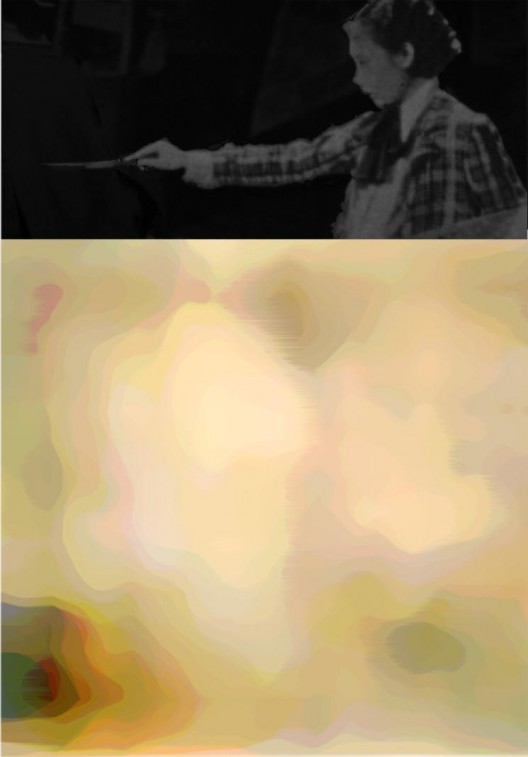Pearl Lam Galleries
Shanghai—Pearl Lam Galleries is pleased to present Storm Resurrection, a solo exhibition by Chinese Australian artist John Young (b. 1956), opening on 2 July, 2016. The exhibition will bring together three series of works: Storm Resurrection, Naïve and Sentimental Paintings, and Veil. Using his “human-computer friendship” method, Young melds contemporary technology with oil painting techniques in his signature works, drawing on an innate human sentiment in his selection of presented images to create art that engages with the anachronistic condition of painting in the age of photography.
Shaping the core of the exhibition will be works from Young’s new Storm Resurrection series, where the artist manipulates original paintings by Wang Ji Yuan, Guan Liang, Qiu Ti, and other members of the Storm Society, China’s first modern art association, to generate abstract compositions that he later uses oil paint to translate faithfully onto linen. In this series, Young searches for a historical significance that has somehow escaped the cultural consciousness of artists in China, as he tries to rediscover the source of Modernism in China. While the Shanghai Art College never rejected Western Modernist styles of painting, they were reserved in their support of its development in comparison to Chinese painting. In response, societies were formed after class and off-campus to maintain its development, which is how the Storm Society was conceived. However, with little attention or appreciation for the Western style they espoused, the Society ceased to exist after four exhibitions and twelve issues of their periodical. Selecting these works as the basis for his series, Young puts forth his belief in the retrospective importance of this movement as a breakthrough towards Modernism in China.
Young’s Naïve and Sentimental Paintings series serves as an introduction to his oeuvre as a whole with its reference to early Western Modernist paintings. The title was inspired by Minimalist composer John Adams’ Naïve and Sentimental Music, which itself derived its name from Friedrich von Schiller’s 1795 essay “On Naïve and Sentimental Poetry”. Schiller classifies all poetry as either naïve or sentimental; the former is recognised by direct description of a straight narrative, while the latter is self-reflective and built around the author’s reflections and relationship to the material. An understanding of Young’s process is important in relating it to the title. Working from a database of thousands of random images downloaded from the Internet, the artist generates his abstract images through computer software that applies predetermined Photoshop filters through batch processing. The resulting “automatic” composites are then assessed before the artist makes his selection. The choice of the image to be painted, out of a batch of thousands of blindly transformed images, relies on a certain innate sentiment, an emotive variable, or a resonance that catches the artist’s eye. The mechanical overtones of his practice should not be viewed as a hindrance to the emotive aspect of the work, as Young aims for technological convergence, to take computer imagery and merge it with traditional technology such as oil painting.
Young’s Veils, an ongoing series that was first created eight years ago, similar to the Naive and Sentimental Paintings, is influenced by Mark Rothko and Morris Louis, two New York Colour Field painters who worked in the 1950s and 60s. The works use deep, intense colour to engage the viewer, in some ways reminiscent of Morris’s drip paintings with the suggestion of paint flowing from the top edge of the canvas. Young’s photo-paintings are as much about the medium of paint as they are an encounter between Western and Eastern pictorial traditions, giving the “chance” image a tactile density in his layering of paint. Even the elusive overlapping colour on the digital image is transformed on linen, where the suggested overlap is made real.
While Young’s academic background in philosophy is evident in his works’ strong conceptual foundation, he also attempts to reintroduce the aesthetics of painting into the domain of a conceptual practice. Well read in the area of 1960s conceptual art, Young moves in an opposing direction from the formative conceptualists of the period. Instead of working exclusively within the realm of documentation and typewritten text, Young approaches abstract painting from a point of view that refuses to denigrate aesthetics (as the original conceptualists often did). For Young, it is essential that the audience grasps the sheer intellectual capability embedded within his paintings.
About the Artist
John Young Zerunge was born in Hong Kong in 1956 and moved to Australia in 1967. He read philosophy of science and aesthetics at the University of Sydney and then studied painting and sculpture at Sydney College of the Arts, specifically with the conceptual artist Imants Tillers and musical prodigy David Ahern. He currently lives and works in Melbourne.
Young’s investigation of Western late modernism prompted significant phases of work from a bicultural viewpoint, including the creation of the following series of paintings in the last four decades: the Silhouette Paintings, the Polychrome Paintings, the Double Ground Paintings, and the Abstract Paintings. Recently Young’s work has focused on transcultural humanitarianism with two projects entitled Bonhoeffer in Harlem and Safety Zone. Bonhoeffer in Harlem, a tribute to Dietrich Bonhoeffer, was installed at St. Matthaus Church, Kulturforum in Berlin in 2009 and in Bamberg, Germany as part of the Circles festival in 2013. Safety Zone, a tribute to 21 foreigners who saved the lives of 300,000 citizens during the Rape of Nanjing in 1937, was shown at the University of Queensland Art Museum in 2011, and it was more recently brought to the Museum of Australian Democracy at Eureka, Ballarat.
Since his first exhibition in 1979, Young has exhibited extensively in major national and international shows at institutions such as the Solomon R. Guggenheim Museum, New York and museums and institutions in North America, Europe, North and Southeast Asia. In 2005–6, a survey of his work entitled Orient/Occident: John Young 1978–2005 was exhibited at the TarraWarra Museum of Art, Victoria. Young has devoted a large part of his career towards regional development in Asia, and he has participated in many regional group travelling exhibitions, including The Rose Crossing (1999–2001, Singapore, Hong Kong, Australia), Systems End (1996, Japan and Korea), AGWA’s Confess and Conceal (1993, all Southeast Asian Museums), as well as Transcultural Painting (1994–5, Taiwan, China, Hong Kong), and Asialink’s Art from Australia: Eight Contemporary Views, (1991, South East Asian Museums), He was also seminal in establishing in 1995 the Asian Australian Artists’ Association (Gallery 4A), now the 4A Centre for Contemporary Asian Art, a centre for the promotion of Asian philanthropy and the nurturing of Australasian artists and curators. Young was awarded the Australia Council Visual Arts Fellowship to support the research and development of this area of his practice in 2012–14.
About Pearl Lam Galleries
Founded by Pearl Lam, Pearl Lam Galleries is a driving force within Asia’s contemporary art scene. With over 20 years of experience exhibiting Asian and Western art and design, it is one of the leading and most established contemporary art galleries to be launched out of China.
Playing a vital role in stimulating international dialogue on Chinese and Asian contemporary art, the Galleries is dedicated to championing artists who re-evaluate and challenge perceptions of cultural practice from the region. The Galleries in Hong Kong, Shanghai, and Singapore collaborate with renowned curators, each presenting distinct programming from major solo exhibitions, special projects, and installations to conceptually rigorous group shows. Based on the philosophy of Chinese literati where art forms have no hierarchy, Pearl Lam Galleries is dedicated to breaking down boundaries between different disciplines, with a unique gallery model committed to encouraging cross-cultural exchange.
The four branches of Pearl Lam Galleries in Hong Kong, Shanghai and Singapore represent an increasingly influential roster of contemporary artists. Chinese artists Zhu Jinshi and Su Xiaobai, who synthesise Chinese sensibilities with an international visual language, are presented internationally with work now included in major private and public collections worldwide. The Galleries has also introduced leading international artists, such as Jenny Holzer, Leonardo Drew, Carlos Rolón/Dzine and Yinka Shonibare MBE, to markets in the region, providing opportunities for new audiences in Asia to encounter their work. Pearl Lam Galleries encourages international artists to create new work which engages specifically with the region, collaborating to produce thought-provoking, culturally relevant work.




